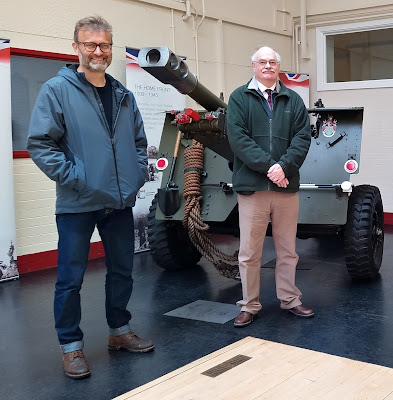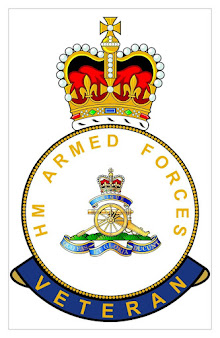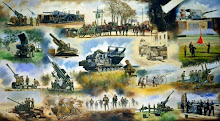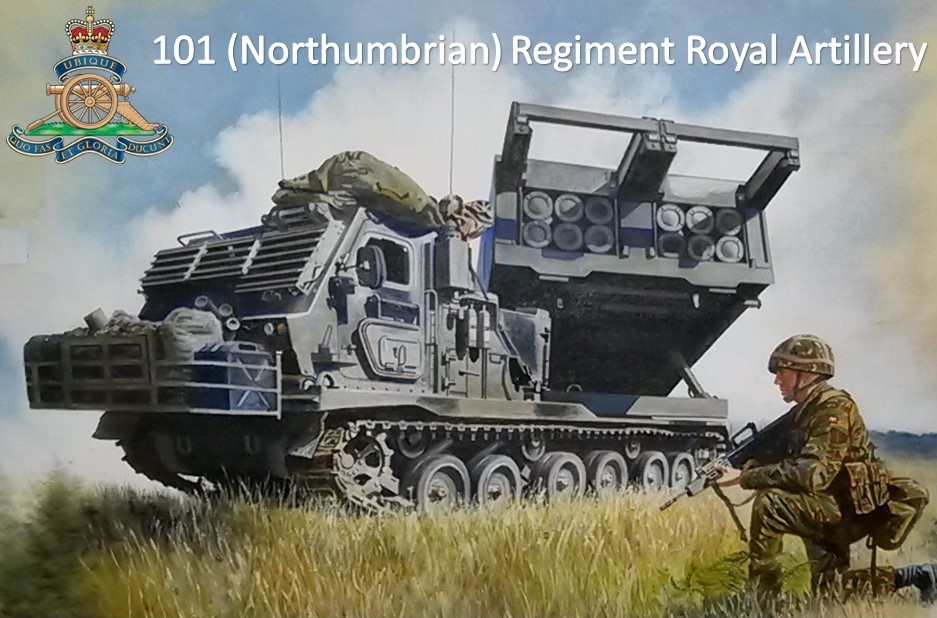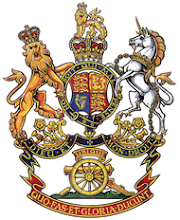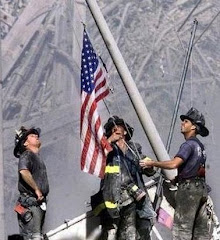| NVAA Battlefield Tour Arras 2017 |
Sunday 26 March 2017
Arras - Bucquoy Road Cemetery
On the 20th May 1940 1st Battalion Tyneside Scottish (Black Watch) engaged with troops of the German 8th Panzer Division. The action took place between the villages of Mercatel and Ficfieux, 7km (4miles) south of Arras.
L/Cpl Piper Freddie Laidler playing pipes which had piped the Tyneside Scottish into Battle at La Boisselle on the first day of the Somme rallied the troops. The lightly armed Tyneside Scots fought heroically and held the German advance, gaining vital hours for BEF retreating to Dunkirk. They sustained heavy casualties.
Overlooking the battlefield the Bucquoy Road Cemetery contains the graves of 64 Tyneside Scots who lost their lives during the action.
 |
| Bucquoy Road Cemetery Looking towards Fichieux |
 |
| Bucquoy Road Cemetery Tyneside Scottish graves |
 |
| Bucquoy Road Cemetery Tyneside Scottish graves |
 |
| Bucquoy Road Cemetery |
 |
| Bucquoy Road Cemetery L/Cpl Frederick Laidler 1st Battalion Tyneside Scottish |
 |
| Bucquoy Road Cemetery L/Cpl Laiders grave |
Freddie Laidler was the uncle of Dire Straits guitarist Mark Knopfler who wrote a song to remember his uncle.
PIPER TO THE END
When I leave this world behind me
to another I will go
And if there are no pipes in heaven
I'll be going down below
If friends in time be severed
someday we will meet again
I'll return to leave you never
be a piper to the end
to another I will go
And if there are no pipes in heaven
I'll be going down below
If friends in time be severed
someday we will meet again
I'll return to leave you never
be a piper to the end
This has been a day to die for
Now the day is almost done
Up above, a quiet seabird
turns to face the setting sun
Now the evening dove is calling
and all the hills are burning red
And before the night comes falling
clouds are lined with golden thread
Now the day is almost done
Up above, a quiet seabird
turns to face the setting sun
Now the evening dove is calling
and all the hills are burning red
And before the night comes falling
clouds are lined with golden thread
We watched the fires together
shared our quarters for a while
walked the dusty roads together
came so many miles
shared our quarters for a while
walked the dusty roads together
came so many miles
This has been a day to die on
Now the day is almost done
Here the pipes will lay beside me
silent with the battle drum
If friends in time be severed
someday we will meet again
I'll return to leave you never
be a piper to the end
Now the day is almost done
Here the pipes will lay beside me
silent with the battle drum
If friends in time be severed
someday we will meet again
I'll return to leave you never
be a piper to the end
Saturday 25 March 2017
Arras - Roclincourt Valley Cemetery
 |
| Roclincourt Valley Cemetery Cross Of Sacrifice |
 |
| Roclincourt Valley Cemetery Royal Artillery Graves |
Lieutenant Bennell was killed in action 16th April 1917 serving with 315 Brigade Royal Field Artillery, The 2nd line Northumbrian Brigade were part of the Divisional Artillery of the Royal Naval Division. In May 1916 they were designated 315 Royal Field Artillery.
Donald Bruce Bennell was born in 1886 the son of Leslie and Friedan Bennell of Fulham. He enlisted into the Royal Horse Artillery in 1903 and served 7 years in India. He rose to the rank of Sergeant. At the beginning of WW1 he entered the Western Front on 5th October 1914 serving in 14 Brigade Royal Horse Artillery, part of the 7th Division. The Division was a newly formed Division, the first to augment the original six Divisions of the British Expeditionary Force, bringing together units from throughout the Empire.
The 7th Division saw considerable action. They served at the Siege of Antwerp, First Battle of Ypres 1914 and in the battles of Neuve Chapelle, Aubers Ridge, Festubert, Loos in 1915. By October 1915 Donald Bennell had reached the position of Battery Sergeant Major. He was commissioned in the field 19th October 1915.
He was made a temporary Lieutenant in April 1916 and by then he was serving with the Northumbrian Brigade.
The war diary of 315 Brigade RFA, 2nd July 1916, details their deployment to the Western Front with Lt Bennell as Adjutant. On 31st August 1916 the Brigade was re-organised from 4 guns per battery to 6 guns per battery. As part of this reorganisation Lt Bennell was posted to A Battery. The Brigade was designated an Army Brigade 1st March 1917 and would be allocated where ever additional artillery support was required.
On 14th April 1917, 315 Army Brigade came under the orders of XIII (13) Corps and deployed between Willerval and Gavrelle. The Divisional axis was on Oppy.
The war diary for 14th April 1917 records LIEUT DONALD BENNELL of A Battery Killed in action.
The war diary for 14th April 1917 records LIEUT DONALD BENNELL of A Battery Killed in action.
CWGC - LIEUTENANT DONALD BRUCE BENNEL
Rank: Lieutenant
Date of Death: 16/04/1917 Age: 31
Regiment/Service: Royal Field Artillery 315th Bde.
Grave Reference: I. E. 1.
Cemetery: ROCLINCOURT VALLEY CEMETERY
Rank: Lieutenant
| Roclincourt Valley Cemetery |
Arras - Arras Memorial
Located in the Faubourg d 'Amiens Cemetery is the Arras Memorial. It commemorates 34,785 British, South African and New Zealand soldiers who have no known grave who died in the Arras area from Spring 1916 to 7th August 1918.
The memorial was designed by Sir Edward Lutyens and unveiled by Lord Trenchard 31st July 1932.
The memorial wall records 11 VC winners.
The memorial lists Lt Walter Tull , the first mixed heritage infantry officer to be commissioned . Tull had been a professional footballer before the war with Tottenham Hotspur and Northampton Town. He volunteered for the Footballers Battalion (Middlesex Regiment). He rose to the rank of Sergeant and commissioned into the Middlesex Regiment 3o May 1917. Tull fought on the Italian from November 1917 to March 1918, returning to the Western Front on the 8th of that month. He was killed 25th March 1918 when the Germans launched their Spring Offensive.
The memorial was designed by Sir Edward Lutyens and unveiled by Lord Trenchard 31st July 1932.
 |
| Arras Memorial and Air Services Memorial Faubourg d 'Amiens Cemetery |
 |
| Arras Memorial Inscription Faubourg d 'Amiens Cemetery |
1914 - 1918
HERE ARE RECORDED THE NAMES OF 35942 OFFICERS AND MEN OF THE FORCES OF THE BRITISH EMPIRE WHO FELL IN THE BATTLE OF ARRAS OR IN AIR OPERATIONS ABOVE THE WESTERN FRONT AND WHO HAVE NO KNOWN GRAVE.
The memorial wall records 11 VC winners.
The memorial lists Lt Walter Tull , the first mixed heritage infantry officer to be commissioned . Tull had been a professional footballer before the war with Tottenham Hotspur and Northampton Town. He volunteered for the Footballers Battalion (Middlesex Regiment). He rose to the rank of Sergeant and commissioned into the Middlesex Regiment 3o May 1917. Tull fought on the Italian from November 1917 to March 1918, returning to the Western Front on the 8th of that month. He was killed 25th March 1918 when the Germans launched their Spring Offensive.
 |
| Lt Walter Tull Commemorated Arras Memorial |
 |
| Arras Memorial Royal Artillery panel Faubourg d 'Amiens Cemetery |
Northumbrian Gunners Commemorated Arras Memorial
Rank
|
Initials
|
Surname
|
Awards
|
Unit
|
Gnr
|
W
|
CARVER
|
"A" Bty. 250th Bde.
| |
Gnr
|
W
|
KNAPP
|
"A" Bty.
250th Bde.
| |
Sjt
|
W
|
WALLACE
|
D C M
|
"A" Bty.
250th Bde.
|
Gnr
|
T
|
HUNTER
|
"D" Bty.
251st Bde.
| |
Gnr
|
G A
|
EALES
|
"A" Bty.
252nd Bde.
| |
Gnr
|
H
|
EARL
|
"C" Bty.
315th Bde.
| |
Sjt
|
A W
|
GILBERT
|
"D" Bty.
315th Bde.
| |
Dvr
|
E R
|
HENNELL
|
"C" Bty.
315th Bde.
| |
Gnr
|
G
|
MAHY
|
"A" Bty.,
315th Bde.
| |
Gnr
|
W N
|
MARSHALL
|
"C" Bty.
315th Bde.
| |
Bde
|
H D
|
MITCHELL
|
"D" Bty.
315th Bde.
| |
Gnr
|
C
|
MOISEY
|
"B" Bty.
315th Bde.
| |
Dvr
|
W W
|
NORVELL
|
"A" Bty.
315th Bde.
| |
Gnr
|
R J
|
WEEKES
|
"C" Bty.
315th Bde.
| |
Gnr
|
C C E
|
DEEBLE
|
"D" Bty.
317th Bde.
| |
F/ Sjt
|
E
|
FLYNN
|
"D" Bty.
317th Bde.
| |
Gnr
|
J
|
MATTHEW
|
"A" Bty.
317th Bde.
| |
Gnr
|
W H
|
ADAMS
|
"D" Bty.
160th Bde.
| |
2. Lt
|
H T
|
BIRD
|
160th Bde.
| |
Gnr
|
J T
|
HOLLINSHEAD
|
"B" Bty.
160th Bde.
| |
Gnr
|
A
|
JACKSON
|
"A" Bty.
160th Bde.
| |
L/ Bde
|
C
|
LAW
|
MM
|
"C" Bty.
160th Bde.
|
Dvr
|
E
|
MARSH
|
"C" Bty.
160th Bde.
| |
Bde
|
F
|
NEWTON
|
"A" Bty.
160th Bde.
| |
Gnr
|
T
|
RENWICK
|
"A" Bty.
160th Bde.
| |
Cpl
|
J W
|
TAYLOR
|
"C" Bty.
160th Bde.
| |
Lt
|
J C
|
YATES
|
160th Bde.
|
Arras - Faubourg-d'Amiens Cemetery
The Faubourg-d'Amiens Cemetery contains over 2,650 graves of which 10 are unidentified. The majority of casualties belong to Commonwealth forces from World War One. Other Great War casualties nationalities include Germans. The key events that resulted in casualties were the Battle of Arras offensive of April-May 1917, and the German Spring Offensive 1918.
There are 8 WW2 burials including aircrew.
Adjacent to the cemetery is the Arras Memorial and the Arras Flying Services Memorial which commemorate those with no known graves.
Major RS Griffiths - 123 SB RGA
Major B Edwards - 247 SB RGA
There are 8 WW2 burials including aircrew.
Adjacent to the cemetery is the Arras Memorial and the Arras Flying Services Memorial which commemorate those with no known graves.
 |
| Faubourg-d'Amiens Cemetery Cross of Sacrifice |
 |
| Faubourg-d'Amiens Cemetery |
 |
| Faubourg-d'Amiens Cemetery Memorial Wall and Air Services Memorial |
 |
| Faubourg-d'Amiens Cemetery Memorial Wall and Air Services Memorial |
 |
| Faubourg-d'Amiens Cemetery Gefreiter Walter Lachmann German Army Private John Bell 3rd Battalion Tyneside Scottish (23 NF) |
 |
| 2.Lt Frederick Noel Coates 22 NF - 3rd Tyneside Scottish |
 |
| Reverend Charles Wand Mitchell Army Chaplains Department attached 8th East Yorks |
Royal Artillery
 |
| Faubourg-d'Amiens Cemetery Gunner Graves |
2.Lt JM Anderson - C Bty / 70 Bde RFA
2.Lt HP Webb - 71 Bde. RFA
2.Lt HJ Goodwin - 135 SB RGA
2.Lt Bostock - B Bty / 162 Bde RFA
Major F Graham DSO MC - 71 Bde RFA
Lt AC Strachan MC & Bar - C Bty/ 70 Bde RFA
Lt C King - 1/1 Glamorgan Bty RHA
Lt AS MacLauchlan - 405 SB RGA
Lt. WC Bannister - 405 SB RGA
2.Lt SF Brown - 239 SB RGA
Major NB Sinclair Travis 297 SB RGAMajor RS Griffiths - 123 SB RGA
Major B Edwards - 247 SB RGA
Gunner RP Jones - 183 SB RGA
Driver WA Jones - 122 Bty / 52 Bde. RFA
Indian Artillery
 |
| Faubourg-d'Amiens Cemetery Indian Gunner Graves |
 |
| Faubourg-d'Amiens Cemetery Indian Gunner Graves |
Arras - Flying Services Memorial
Within the confines of the Faubourg d'Amiens Cemetery is the Arras Flying Services Memorial.
The memorial commemorates 989 airmen of Empire Forces who were killed on the Western Front during World War I, and who have no known grave. The memorial was designed by Edwin Lutyens, and unveiled by Hugh Trenchard, 1st Viscount Trenchard, Marshal of the Royal Air Force on 31 July 1932.
Commemorated on the Memorial are British servicemen lost whilst serving with the Royal Flying Corps (RFC) and the Royal Naval Air Service (RNAS) , and after 1st April 1918, the Royal Air Force (formed by the amalgamation of the RFC and RNAS). Also listed are members of Empire forces who served with British air units.
The selection of Arras as the location of the Air Service was appropriate as the sector was where the Royal Flying Corps suffered heavy casualties in April 1917, 'Bloody April'.
Amongst those listed on the Air Services Memorial is Major 'Mick' Mannock VC, DSO and Two Bars, Military Cross and Bar. At the beginning of the war 'Mick' Mannock was working as a telephone engineer in Turkey and interned. He fell ill and was repatriated. He joined the Army, and in 1916 transferred to the Royal Flying Corps. Posted to the Western Front he won his first air victory on 7th May 1917. He would go to win a further 60 victories to bring his total to 61. He was killed in action 26th July 1918.
In the 14 months 'Mick' Mannock was engaged in aerial combat he was awarded the Distinguished Service Order three times, the Military Cross twice and posthumously awarded the Victoria Cross.
The memorial commemorates 989 airmen of Empire Forces who were killed on the Western Front during World War I, and who have no known grave. The memorial was designed by Edwin Lutyens, and unveiled by Hugh Trenchard, 1st Viscount Trenchard, Marshal of the Royal Air Force on 31 July 1932.
ARRAS FLYING SERVICES MEMORIAL - CWGC
 |
| Arras Flying Services Memorial Faubourg d' Amiens Cemetery |
The selection of Arras as the location of the Air Service was appropriate as the sector was where the Royal Flying Corps suffered heavy casualties in April 1917, 'Bloody April'.
The Germans had gained superiority in terms of pilot training and aircraft technology. They had reorganised to form specialist fighter units. Led by highly experienced pilots such as Baron Von Richthofen the Germans inflicted heavy losses on the British pilots. During April 1917, the British lost 245 aircraft with 211 aircrew killed or missing and 108 as prisoners of war. This compared with the German Air Services recorded losses of 66 aircraft during the same period.
Amongst those listed on the Air Services Memorial is Major 'Mick' Mannock VC, DSO and Two Bars, Military Cross and Bar. At the beginning of the war 'Mick' Mannock was working as a telephone engineer in Turkey and interned. He fell ill and was repatriated. He joined the Army, and in 1916 transferred to the Royal Flying Corps. Posted to the Western Front he won his first air victory on 7th May 1917. He would go to win a further 60 victories to bring his total to 61. He was killed in action 26th July 1918.
 |
| Major Edward Mannock VC DSO** MC* |
Major Edward Mannock VC DSO** MC*
 |
| Victoria Cross / Distinguished Service Order 2 + Bars / Military Cross + Bar |
Arras - Monchy le Preux
The village of Monchy le Preux lies 10km SE of Arras and was one of the objectives to be captured by VI Corps on 9th April when the Battle of Arras was launched. By the eve of the second day of the Battle it was still in German hands.
The village was situated on higher round and was key terrain which needed to be captured in order for the Green Line objective to be achieved.
The Third Army issued orders at 23:00 for the 37th Division to renew the attack on the 11th April. Despite orders not being received till 04:00, the attack would commence at 05:00. The men of the Division were roused from their snow covered positions and readied for battle.
The 111h Brigade was on the left, directly facing Monchy, 112th Brigade right, the attack would be supported by six tanks. The attack would be supported on the left flank by the 15th (Scottish) Division. Initially the attack did not go well as the advancing troops were met by heavy machine gun fire from the heavily fortified village. Eventually the infantry broke into the village supported by two tanks.
Information was received at Third Army HQ that Monchy had been taken, and at 08:30 the 8th Cavalry Brigade was ordered to advance North of Monchy to exploit a breakthrough.
The advance was premature, Monchy was held by no more than 150 gallant men and the position was precarious. As the cavalry galloped in to action they met heavy artillery and machine gun fire and they were forced into Monchy.
The Germans then brought every gun they could spare to bear on the village firing a box barrage which gradually moved inwards. As the cavalry men took cover as best they could in trenches, cellars and the ruins of the buildings, the horses were caught in the open resulting in heavy loss. The cavalry joined the infantry in preparing defensive positions to secure Monchy.
The final objective was the Green Line. To renew the offensive fresh Divisions would relieve those currently in the front line. Allotted to IV Corps were the 17th and 29th Divisions, to their south the 50th (Northumbrian) Division would join VII Corps.
The village of Monchy would be allocated to the 88th Brigade of the 29th Division who would attack on 14th April 1917. At 05:30 an artillery barrage supported the advance of the 1st Essex Regiment (left) and the Newfoundland Regiment (right) towards the objective of Infantry Hill.
After 90 minutes the Essex had secured their part of the objective, the Newfoundland Regiment were slowed by heavy machine gun fire. They pressed on. Despite suffering heavy casualties they occupied the enemy front line trenches and continued reaching the high ground of the hill. At this point the Germans counter attacked, small groups of men held on till they were captured or wounded.
At 10:00, The Commanding Officer of the Newfoundland Regiment, Lieutenant-Colonel Forbes-Robertson, gathered the men from his HQ and advanced forward under fire to meet a force of who were advancing towards Monchy. For four hours, ten men held the German attack, "all that stood between the Germans and Monchy, one of the most vital positions on the whole battlefield." (British Official History 1917 Vol 1 page 292). The party were eventually relieved at 14:45 by a platoon of the 2nd Hampshire's and Monchy was saved.
A monument commemorating the actions of the Newfoundland Regiment was erected in Monchy le Preux.
The village was situated on higher round and was key terrain which needed to be captured in order for the Green Line objective to be achieved.
 |
| Battle of Arras Moncy sketch by Captain David Burles of Essex Yeomanry |
The 111h Brigade was on the left, directly facing Monchy, 112th Brigade right, the attack would be supported by six tanks. The attack would be supported on the left flank by the 15th (Scottish) Division. Initially the attack did not go well as the advancing troops were met by heavy machine gun fire from the heavily fortified village. Eventually the infantry broke into the village supported by two tanks.
Information was received at Third Army HQ that Monchy had been taken, and at 08:30 the 8th Cavalry Brigade was ordered to advance North of Monchy to exploit a breakthrough.
 |
| Battle of Arras Cavalry Advancing |
The Germans then brought every gun they could spare to bear on the village firing a box barrage which gradually moved inwards. As the cavalry men took cover as best they could in trenches, cellars and the ruins of the buildings, the horses were caught in the open resulting in heavy loss. The cavalry joined the infantry in preparing defensive positions to secure Monchy.
 |
| Battle of Arras 37th Division Memorial Monchy le Preux |
The village of Monchy would be allocated to the 88th Brigade of the 29th Division who would attack on 14th April 1917. At 05:30 an artillery barrage supported the advance of the 1st Essex Regiment (left) and the Newfoundland Regiment (right) towards the objective of Infantry Hill.
 |
| Battle of Arras Attack from Monchy 14th April 1914 |
After 90 minutes the Essex had secured their part of the objective, the Newfoundland Regiment were slowed by heavy machine gun fire. They pressed on. Despite suffering heavy casualties they occupied the enemy front line trenches and continued reaching the high ground of the hill. At this point the Germans counter attacked, small groups of men held on till they were captured or wounded.
At 10:00, The Commanding Officer of the Newfoundland Regiment, Lieutenant-Colonel Forbes-Robertson, gathered the men from his HQ and advanced forward under fire to meet a force of who were advancing towards Monchy. For four hours, ten men held the German attack, "all that stood between the Germans and Monchy, one of the most vital positions on the whole battlefield." (British Official History 1917 Vol 1 page 292). The party were eventually relieved at 14:45 by a platoon of the 2nd Hampshire's and Monchy was saved.
A monument commemorating the actions of the Newfoundland Regiment was erected in Monchy le Preux.
 |
| Monchy le Preux Newfoundland Regiment Memorial |
Subscribe to:
Posts (Atom)























